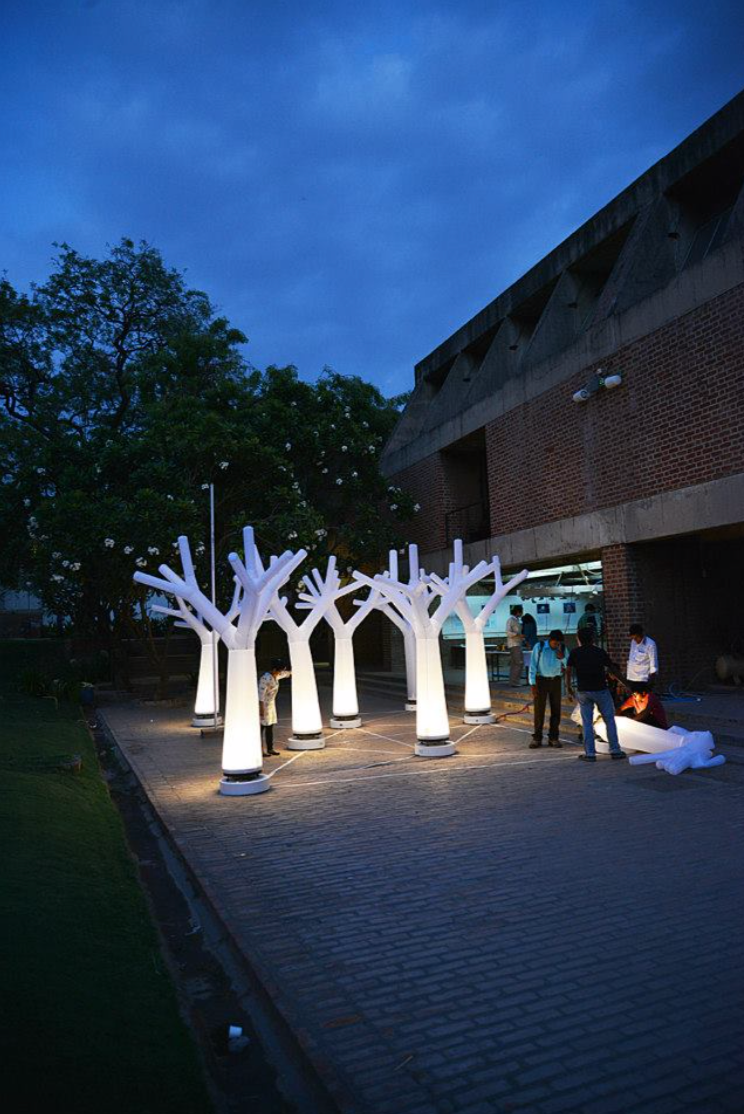top of page

Tools: Autodesk Autocad, Adobe Photoshop, Adobe Illustrator, Rhinoceros 3D.
My Role: Design Strategy, Concept Development, Product Development & Execution.
Project Type: Academic I Summer School at Center for Environmental Planning & Technology
Project Timeline: 3 Weeks
Team: Summer School Batch of 2014
Brief Overview
As a part of the CEPT University Summer School, the Faculty of Design offered a summer school program on Bionics. The domain of the course was smart and adaptive systems that respond to transient changes in the environment.
The outcome of the workshop was 2 installations that were embedded with sensors, actuators, and logic controllers to change form in response to human interaction.
The installations are experiments to fuse Interior Design and Architecture with smart, responsive, and adaptive systems. This would lead to intelligent and responsive spaces that have the ability to self-organize themselves and adapt to multiple efficient configurations with the changes in environmental conditions like temperature, pressure, humidity, human movement, and so on.
The adaptive system is a set of interacting or interdependent entities, real or abstract, forming an integrated whole that together is able to respond to environmental changes or changes in the interacting parts.

Thigmo - Morphogenesis

This refers to the change in shape, structure and material properties of biological organisms in response to the transient changes in environmental conditions.
Natural organisms have advanced sensing devices and actuation strategies which are coherent morpho mechanical systems with the ability to respond to environmental stimulus.

Interactive Blooming Flower

Flowers are an excellent example of responsive systems. It is vital for flowers to bloom in response to sunlight. They change their form, orientation, and even odor to receive sunlight and attract insects. The moonflower which blooms at night was the inspiration of the interactive blooming flower.
The flower was developed with proximity sensors, pneumatic actuators, and embedded logic controllers.
This experiment set the base for ‘The Unfurling Fern’ which we call ‘Walk and Pop’ and the ‘Tree of Life’ installation.
The Unfurling Fern



1/2
The Unfurling Fern as the name suggests is inspired by a sprouting fern. The simple form of the fern leads to a spatial configuration that could be interactive and responsive.
The installation generates curiosity through the display units and extends as an invitation to the visitor. As visitors move through the installation the embedded sensors translate the data of movement to the logic controllers.
The logic controllers are computed to activate the unfurling fern in sequential modules to create an interesting spatial envelope.
The Tree Of Life



1/2
The Tree of Life is a cluster of trees that have the ability to intercommunicate, analyze and evaluate the data of visitors and their movement patterns.
The form of the tree was developed from the Fractal/Branching pattern ‘L’ systems were deployed to deceive the logic, angle, and length of branching.
The trees in this installation can sense the number of visitors and how they move through the cluster. Spontaneously the trees respond to the visitor by a mild movement in the branches.
Over a time module of 10 minutes, the trees intercommunicate amongst themselves and analyze the visitor data, the trees that receive the minimum number of visitor droops down for a while and springs back to life again.
Ideation
Form
Sensing


During the ideation process, we discussed several attributes of smart systems such as form, geometry, sensors, actuation logic, and control parameters.
The group was divided into 4 teams to develop several spatially responsive concepts. Some of the ideas were inspired by Mushrooms, Dragon Fly Wings, Tress, and so on. Some interesting actuation ideas were on Musical Trees, Adaptive staircases, and acoustically transformative structures.
The form of The Unfurling Fern was developed from prototyping rather than CAD modeling. The material played a critical role to achieve the cooling effect of the system. The winding paper of motor amateurs was used which finally did the job after a series of material experiments. The winding paper is coiled up and heat-treated to set the shape.
The form of ‘The Tree of Life’ was developed through parametric modeling on the Rhino-Grasshopper platform ‘L’ (Lind Meyer) systems to derive the branching pattern.
Nevertheless, the propagation of the branching posed several problems during inflation and deflation. We decided to stick to a two-stage propagation to derive an efficient mechanical system.

Biological systems have extremely advanced sensors that prick signals at the nanoscale and respond at a global scale.
Owing to the limited time of the workshop we explored infrared proximity sensors extensively. The reliability of the proximity sensors helped us develop a robust smart system.
The sensors are connected to a 24 DC power supply which on sensing gives an. The electrical signal of 24 DC as an output. This output is then further processed by the programmable logic controller.
bottom of page